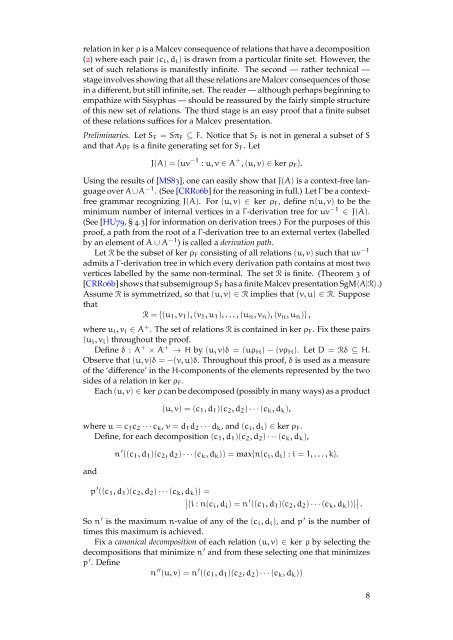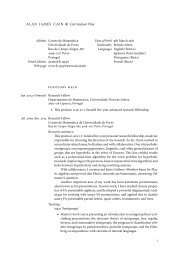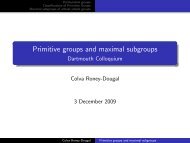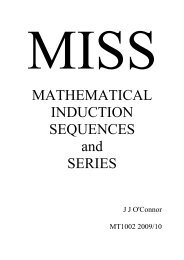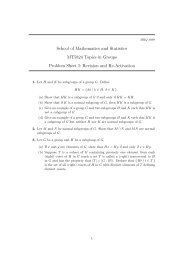Malcev presentations for subsemigroups of direct products of ...
Malcev presentations for subsemigroups of direct products of ...
Malcev presentations for subsemigroups of direct products of ...
You also want an ePaper? Increase the reach of your titles
YUMPU automatically turns print PDFs into web optimized ePapers that Google loves.
elation in ker ρ is a <strong>Malcev</strong> consequence <strong>of</strong> relations that have a decomposition() where each pair (c i , d i ) is drawn from a particular finite set. However, theset <strong>of</strong> such relations is manifestly infinite. The second — rather technical —stage involves showing that all these relations are <strong>Malcev</strong> consequences <strong>of</strong> thosein a different, but still infinite, set. The reader — although perhaps beginning toempathize with Sisyphus — should be reassured by the fairly simple structure<strong>of</strong> this new set <strong>of</strong> relations. The third stage is an easy pro<strong>of</strong> that a finite subset<strong>of</strong> these relations suffices <strong>for</strong> a <strong>Malcev</strong> presentation.Preliminaries. Let S F = Sπ F ⊆ F. Notice that S F is not in general a subset <strong>of</strong> Sand that Aρ F is a finite generating set <strong>for</strong> S F . LetJ(A) = {uv −1 : u, v ∈ A + , (u, v) ∈ ker ρ F }.Using the results <strong>of</strong> [MS], one can easily show that J(A) is a context-free languageover A∪A −1 . (See [CRRb] <strong>for</strong> the reasoning in full.) Let Γ be a contextfreegrammar recognizing J(A). For (u, v) ∈ ker ρ F , define n(u, v) to be theminimum number <strong>of</strong> internal vertices in a Γ-derivation tree <strong>for</strong> uv −1 ∈ J(A).(See [HU, § .] <strong>for</strong> in<strong>for</strong>mation on derivation trees.) For the purposes <strong>of</strong> thispro<strong>of</strong>, a path from the root <strong>of</strong> a Γ-derivation tree to an external vertex (labelledby an element <strong>of</strong> A ∪ A −1 ) is called a derivation path.Let R be the subset <strong>of</strong> ker ρ F consisting <strong>of</strong> all relations (u, v) such that uv −1admits a Γ-derivation tree in which every derivation path contains at most twovertices labelled by the same non-terminal. The set R is finite. (Theorem <strong>of</strong>[CRRb] shows that subsemigroup S F has a finite <strong>Malcev</strong> presentation SgM⟨A|R⟩.)Assume R is symmetrized, so that (u, v) ∈ R implies that (v, u) ∈ R. SupposethatR = {(u 1 , v 1 ), (v 1 , u 1 ), . . . , (u n , v n ), (v n , u n )} ,where u i , v i ∈ A + . The set <strong>of</strong> relations R is contained in ker ρ F . Fix these pairs(u i , v i ) throughout the pro<strong>of</strong>.Define δ : A + × A + → H by (u, v)δ = (uρ H ) − (vρ H ). Let D = Rδ ⊆ H.Observe that (u, v)δ = −(v, u)δ. Throughout this pro<strong>of</strong>, δ is used as a measure<strong>of</strong> the ‘difference’ in the H-components <strong>of</strong> the elements represented by the twosides <strong>of</strong> a relation in ker ρ F .Each (u, v) ∈ ker ρ can be decomposed (possibly in many ways) as a product(u, v) = (c 1 , d 1 )(c 2 , d 2 ) · · · (c k , d k ),where u = c 1 c 2 · · · c k , v = d 1 d 2 · · · d k , and (c i , d i ) ∈ ker ρ F .Define, <strong>for</strong> each decomposition (c 1 , d 1 )(c 2 , d 2 ) · · · (c k , d k ),andn ′ ((c 1 , d 1 )(c 2 , d 2 ) · · · (c k , d k )) = max{n(c i , d i ) : i = 1, . . . , k}.p ′ ((c 1 , d 1 )(c 2 , d 2 ) · · · (c k , d k )) =∣ {i : n(ci , d i ) = n ′ ((c 1 , d 1 )(c 2 , d 2 ) · · · (c k , d k ))} ∣ ∣ .So n ′ is the maximum n-value <strong>of</strong> any <strong>of</strong> the (c i , d i ), and p ′ is the number <strong>of</strong>times this maximum is achieved.Fix a canonical decomposition <strong>of</strong> each relation (u, v) ∈ ker ρ by selecting thedecompositions that minimize n ′ and from these selecting one that minimizesp ′ . Definen ′′ (u, v) = n ′ ((c 1 , d 1 )(c 2 , d 2 ) · · · (c k , d k ))


